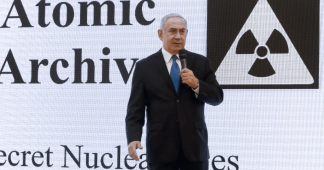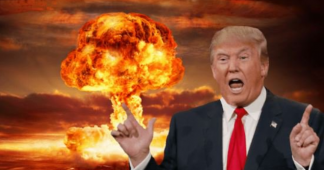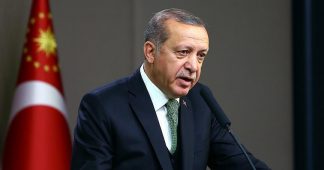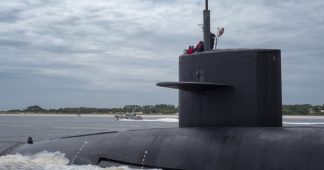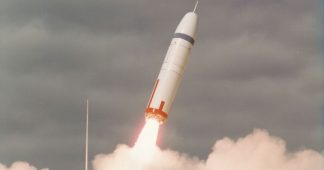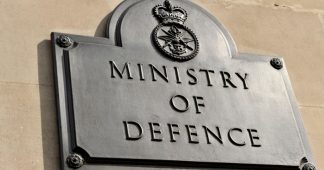A little-noticed, new fuze that better controls a nuclear blast’s timing will enable the United States to more easily destroy protected targets in other countries.
By R. Jeffrey Smith
October 29, 2021
A sophisticated electronic sensor buried in hardened metal shells at the tip of a growing number of America’s ballistic missiles reflects a significant achievement in weapons engineering that experts say could help pave the way for reductions in the size of the country’s nuclear arsenal but also might create new security perils.
The wires, sensors, batteries, and computing gear now being quietly installed on hundreds of the most powerful U.S. warheads give them an enhanced ability to detonate with what the military considers exquisite timing over some of the world’s most challenging targets, substantially increasing the probability that in the event of a major conflict, those targets would be destroyed in a radioactive rain of fire, heat, and unearthly explosive pressures.
The new components — which determine and set the best height for a nuclear blast — are now being paired with other engineering enhancements that collectively increase what military planners refer to as the individual nuclear warheads’ “hard target kill capability.” This gives them an improved ability to destroy Russian and Chinese nuclear-tipped missiles and command posts in hardened silos or mountain sanctuaries, or to obliterate hardened military command and storage bunkers in North Korea, also considered a potential U.S. nuclear target.
The increased destructiveness of the new warheads means that in some cases fewer weapons could be needed to ensure that all the objectives in the nation’s nuclear targeting plans are fully met, opening a path to future shrinkage of the overall arsenal, current and former U.S. officials said in a series of interviews, in which some spoke on condition of anonymity to discuss sensitive technology.
Production of the first of many high-yield nuclear warheads containing the gear, developed over the past decade at a cost of billions of dollars, was completed in July for installation on missiles aboard Navy submarines, the National Nuclear Security Administration announced. It follows the development and installation of similar fuzes — designed by the same nuclear laboratory — on hundreds of smaller-yield submarine warheads in a program completed in January 2019. After the Air Force installs some of the same technology aboard new land-based missiles slated for deployment by the end of the decade, it will be deployed on more than 1,300 warheads in the U.S. arsenal.
The Defense Department has publicly described the components as a routine engineering improvement that provides no substantial new military capabilities. Air Force budget documents provided to Congress describe it as a “form, fit, and functionally equivalent replacement” for existing nuclear warhead fuzes. But those familiar with highly sensitive nuclear planning say it will make the warheads significantly more damaging than previous such weapons.
“It’s an astounding piece of technology,” said mechanical engineer Paul J. Hommert, who directed the government-owned Sandia National Laboratories during the initial years of the technology’s development by a team of several hundred people on its New Mexico campus. He said that while existing U.S. weapons are highly accurate, the sensors the lab created are even better at computing the best moment for a blast to be ignited to produce the highest pressures on targets. They accomplish this even while the warheads approach at speeds that other experts have said exceed 15,682 miles per hour.
“There is more flexibility [in its use] and more robustness,” he said. “And that has to lead to sustained confidence and the possibility of additional damage capability.” Hommert said he agreed with others that there are a lot of deeply buried installations, like command posts, that “these will give you a better chance of holding at risk.” He called it an “underappreciated” enhancement.
Georgetown University professor Keir Lieber, and Dartmouth University associate professor Daryl Press, a consultant to the Defense Department, have estimated that the fuzes have roughly doubled the destructive power of the U.S. submarine fleet alone.
This shift in weapons capabilities has both military and political consequences, current and former officials and experts said. On one hand, the leaders of target countries, knowing that U.S. nuclear strikes are more certain to be effective in destroying their weapons, might be more deterred from taking provocative actions that could draw a U.S. nuclear attack, some said.
Others worry, however, that those leaders — knowing that many of their protected, land-based weapons and associated command posts could not escape destruction — might be more prone to order their use early in a crisis or conflict, simply to ensure they are not destroyed when incoming warheads arrive, promoting a hair-trigger launch policy that could escalate into a general cataclysm.
Physicist James Acton, who co-directs the nuclear policy program at the Carnegie Endowment for International Peace and has written extensively about the need to avert unnecessary conflicts, said that efforts to modernize the nuclear arsenal should be more focused on ensuring the weapons’ safety, security, and reliability, and less on goosing their accuracy.
“If China or Russia believe in a conflict or a crisis that we are going to attack or destroy their nuclear forces and command posts, that gives them an incentive to use nuclear weapons first, or to threaten their use. They have strong incentives to take steps that would further escalate the crisis and create new dangers,” Acton said.
Distributing impressive accuracy improvements throughout the U.S. arsenal “will raise concerns in Russia and China about targeting their leadership.” He said “I would like to see the United States being more restrained in this,” because the additional escalation risks “outweigh a relatively modest increase in utility” against such targets as deeply-buried command posts.
Already, the U.S. can hold at risk many but possibly not all of the key Russian and Chinese targets. “There’s an element that exists today” of heightened fear of preemptive attack as a result, said John R. Harvey, a physicist who was the principal deputy to the Defense Department’s top nuclear weapons authority from 2009 to 2013 and the director of policy planning at the National Nuclear Security Administration for eight years before that.
But Harvey acknowledged that it’s hard to know whether the deployment of additional capabilities to target key enemy warheads will put “the adversary in a posture that would generate a rapid response, which could conceivably be the result of misinterpretation” — a launch of weapons based on the erroneous sensing of an attack or false anxiety about an imminent attack.
Detonating at the optimal second
The warhead fuze and its accompanying sensors and computers are embedded in a stubby capsule about two feet high and a foot wide, compact enough for Hommert to carry a model with him to a congressional hearing in 2014. There he said they would be installed on three new types of warheads atop land and sea-based missiles as well as, in part, a warhead to be carried by U.S. F-16 and F-35 warplanes deployed in Europe.
Hommert and other advocates for the new technology emphasized that by deploying a single new component across the warhead force — a rare exception to the longstanding insistence of the Navy and the Air Force on using unique warhead designs — the government would save around $170 million. But in practice, the decision to field a common device backfired, when a $5 capacitor in the fuzing system that stores and generates electrical current tested poorly and had to be abruptly replaced by a more expensive device in hundreds of the modules. The resulting production delays set the entire effort back about a year and led to a roughly $750 million hike in its budget.
Widespread installation of the fuzing system nonetheless has aroused little controversy on Capitol Hill, partly because both Democratic and Republican administrations have depicted it as a slight modernization of a single component that they say doesn’t violate a 2010 promise by President Barack Obama to foreswear the development of new nuclear weapons or their modification to support new military missions.
It’s part of a major, two-decade long effort to modernize major components in five types of existing nuclear warheads at a cost exceeding $40 billion. The government is also simultaneously modernizing virtually all the launchers for these warheads, including key elements in the U.S. missile, bomber, and submarine force, requiring an investment of $634 billion over the next decade and bringing the complete cost of the nuclear arsenal to roughly $1.2 trillion over the next three decades.
Officials say the ambition of the Sandia team was partly to make the fuze of U.S. warheads more resilient in the face of electronic jamming efforts (typically aimed at making a fuze malfunction or detonate too early) and in the midst of high radiation levels caused by other nuclear blasts, including those deliberately set off by Russia at an altitude of about 30 miles over key command centers as part of that country’s brutalist missile defense system.
But another aim was to ensure that warheads arriving from varied angles could more assuredly obliterate their targets even if their prospective landing points were slightly off-center.
Older warheads set to detonate when they hit the ground, using a contact fuze, or those that used a less advanced radar or barometric fuze to ignite it at a pre-set altitude were not as assuredly able to destroy all hardened targets, says Theodore Postol, a professor emeritus of science, technology and national security policy from MIT and former consultant to the chief of naval operations on warhead engineering. Bursts too close to the ground or on it also caused higher radioactive fallout and more collateral damage.
“The new radar has the ability to measure the altitude within a few meters of precision” and “can tell you whether you are on the right trajectory” by sensing terrain features. Taking into consideration winds, gravitational forces, and other sensitive flight characteristics, it senses how far off the warhead might land and compensates by adjusting the burst height to maintain the maximum possible force on the target, he said.
Several experts said that enabling the warheads to determine their location while traveling at blinding speed and in milliseconds calculate the right moment to ignite proved a solvable problem with advanced electronics and a team working for a decade with what Sandia boasts is “some of the best tools, equipment and research facilities in the world.”
Citing the sensitive nature of the technology in the assembly, the lab declined to make a member of its staff available to discuss it; nor would the National Nuclear Security Administration in Washington, which funded the work. But a Sandia employee overseeing the work, Dolores Sanchez, was quoted in a lab publication in August describing the assembly as “the brains of the warhead. … It looks for the correct code and the correct environmental signals that will unlock the system, and it also ensures that it’s an authorized flight. In short, it makes sure it always works when we want it to and never when we don’t.”
The lab’s news release explained further that it was “more than a decade in the making” and that it required multiple tests of the fuze’s vulnerability to “impact, vibration, drops, extreme temperatures and massive electrical impulses.” Sandia’s design was subsequently turned into hardware by Honeywell, which not only manages the lab but operates the federally-owned nuclear weapons production facility in Kansas City that’s churning out hundreds of the new systems.
One of the aircraft-delivered warheads that incorporates the fuzing system’s new radar and a new, maneuverable tailkit, the B61-12, will be considerably more accurate than its predecessors but have a lower explosive force, producing somewhat less radioactive fallout and destruction outside the vicinity of the target. Both of the submarine-based warheads with the parts of the new fuzing and firing gear, the W76-1 and W88 Alt 370, are also meant to be more destructive, a circumstance that affords the submarines’ commanders more latitude to station their vessels in a broader ocean area and launch their missiles toward their targets along more varied trajectories, officials say.
Building weapons like the B-61 that are more accurate and destructive while producing lower collateral damage “makes them easier to use, [and] this is completely accepted now” as a reasonable ambition for weapons designers, Kristensen complained. The issue has been hotly debated, however. Don Cook, who helped oversee nuclear weapons production efforts during the Obama administration, wrote in 2016 that “I believe, a lower-yield, more accurate U.S. weapon constitutes a better deterrent specifically because it will be regarded by an adversary as more usable and that the likelihood of weapons use is, therefore, lower, not higher.”
A new path to nuclear reductions?
But Navy Admiral Charles A. Richard, who commands the U.S. Strategic Command that stewards the nuclear arsenal, told the House Armed Services Committee last April that “the size of a nation’s weapons stockpile is a crude measure of its overall strategic capabilities. … It is necessary to consider the capability, range, and accuracy of the associated delivery systems.”
Richard’s words were intended to rebut any claims that China’s nuclear arsenal — which has an estimated 350 warheads, or less than a tenth of those deployed and stored by U.S. forces — poses a comparatively small threat to America. “I have no choice but to view China as a significant strategic nuclear threat,” Richards said.
But other experts say the same conclusions can be drawn from the improved capabilities of the U.S. force. Their enhanced nuclear killing power justifies taking a look at the plan to spend a trillion dollars on its modernization, operation and maintenance, or the need to keep so many warheads in the stockpile, they say.
The fuze will be “more reliable, almost certainly,” said Michael Elliott, a former nuclear bomber weapons system officer who was deputy director of strategic stability for the Joint Chiefs of Staff while the New START treaty was negotiated and previously worked on nuclear plans for the U.S. Strategic Command. “When you improve reliability, you improve effectiveness, and that drives up the probability of success,” which could mean that “fewer warheads are needed,” including fewer required in a stockpile reserve that others say presently has 2,000 warheads. But Elliott added that any decision to reduce warheads should also be based on “the projected strategic situation and health of our forces.”
“Our hard-target kill capability was good before, but it’s great now,” said Jon Wolfsthal, a key White House adviser on arms control and nuclear issues when Biden was vice president. He said this enhancement had already helped convince the Pentagon’s military leaders to agree that the nuclear force could be smaller than it was then and is now.
President Obama made this verdict public in June 2013 after a comprehensive classified review, through a statement affirming that even after the New START limitations were fully met, “we can ensure the security of the United States and our allies and partners and maintain a strong and credible strategic deterrent while safely pursuing up to a one-third reduction in deployed nuclear weapons” beyond what that treaty required.
Wolfsthal, who is now a senior adviser to the Global Zero advocacy group, which seeks the eventual elimination of nuclear arms, said the military’s support for this reduction of a third — or about 500 warheads — from the current arsenal wasn’t conditioned during the Obama administration’s review on a requirement for similar reductions to be taken by Russia, but was decided instead based on an assessment of what the country needed to be able to hold key Russian targets at risk. He and others explained that this was determined in part by a recognition that the American arsenal was becoming more accurate and in part by the fact that the total number of targets that America needed to destroy in Russia had declined.
Wolfsthal said that in his view the reason Obama didn’t implement these approved reductions was political, rather than military. Obama and Biden, he said, opposed taking action unilaterally because they hoped to persuade Russia to act similarly, contributing to an overall reduction in global nuclear risks. He said he thought it was “crazy” to be spending so much on new weapons when “we could live with a smaller force.”
So far, the Biden administration has said little about its larger plans for the nuclear arsenal besides affirming in budget plans that it intends no major change in the modernization programs created by Obama and continued or slightly expanded by President Donald Trump. An internal administration review of the nation’s nuclear posture is just getting under way at the Pentagon, and its leadership changed, drawing expressions of concern from arms control advocates.
Leonor Tomero, a comparatively independent-minded veteran of nuclear oversight on Capitol Hill who Biden had appointed early this year as the deputy policy chief for nuclear matters, was relieved of responsibility for the review and it was handed off to another defense official working in an acting capacity.
While the administration described the resulting personnel change as a simple interoffice reorganization, Sen. Ed Markey, D-Mass., said in a Sept. 24 letter to Biden that he was “concerned that the sudden departure of a top appointee, charged with presenting you options on the future of the U.S. nuclear weapons enterprise, will result in a draft Nuclear Posture Review that reflects the Cold War era’s overreliance on nuclear weapons.”
Any prospect of changing paths indeed feels alarming to some. Richard, the Strategic Command commander, told reporters in January that the upcoming review should include “validation that we like the strategy that we have. … And then to be satisfied that the [nuclear weapons] capabilities that we have are able to accomplish that.”
But Andrew Weber, the assistant secretary of defense for nuclear, chemical, and biological defense programs from 2009 to 2014 and chair of the Nuclear Weapons Council that approved development of the fuzes, said that in his view their deployment reduces the need to keep developing some smaller nuclear weapons slated for deployment in the next decade.
New air- and sea-launched cruise missiles in particular, he said, are not necessary, and will undermine deterrence because they are stealthy, surprise-attack weapons that will make opponents nervous enough to adopt hair-trigger launch policies. Since they can be deployed with both conventional and nuclear warheads and it’s impossible for opponents to tell the difference, their use could cause unintentional escalation from a conventional to a nuclear war.Those two programs are estimated to cost more than $35 billion. It’s time, Weber said, to stop “replacing everything mindlessly.”
Published at publicintegrity.org
We remind our readers that publication of articles on our site does not mean that we agree with what is written. Our policy is to publish anything which we consider of interest, so as to assist our readers in forming their opinions. Sometimes we even publish articles with which we totally disagree, since we believe it is important for our readers to be informed on as wide a spectrum of views as possible.
